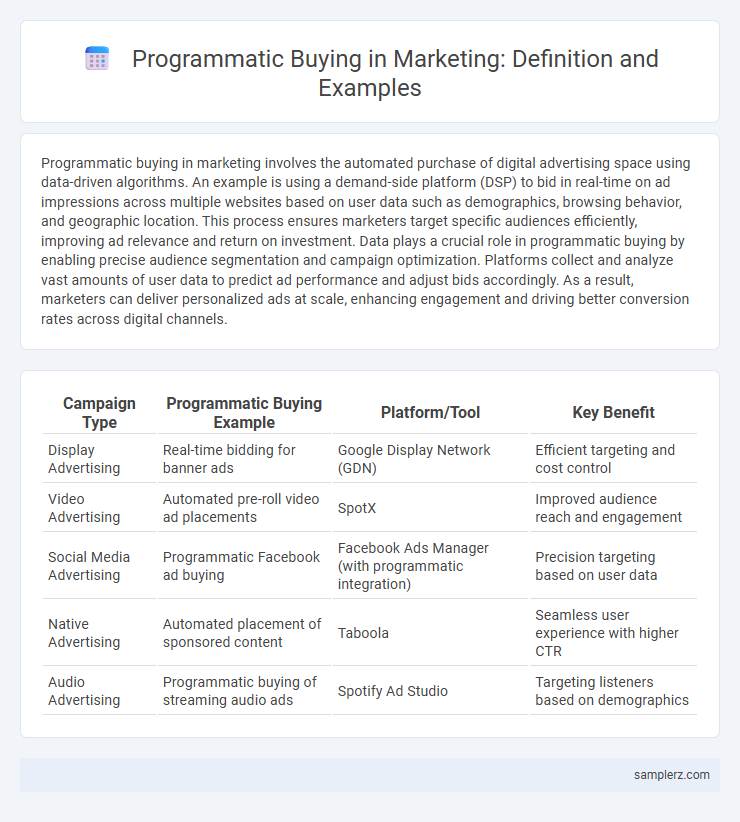Programmatic buying in marketing involves the automated purchase of digital advertising space using data-driven algorithms. An example is using a demand-side platform (DSP) to bid in real-time on ad impressions across multiple websites based on user data such as demographics, browsing behavior, and geographic location. This process ensures marketers target specific audiences efficiently, improving ad relevance and return on investment. Data plays a crucial role in programmatic buying by enabling precise audience segmentation and campaign optimization. Platforms collect and analyze vast amounts of user data to predict ad performance and adjust bids accordingly. As a result, marketers can deliver personalized ads at scale, enhancing engagement and driving better conversion rates across digital channels.
Table of Comparison
| Campaign Type | Programmatic Buying Example | Platform/Tool | Key Benefit |
|---|---|---|---|
| Display Advertising | Real-time bidding for banner ads | Google Display Network (GDN) | Efficient targeting and cost control |
| Video Advertising | Automated pre-roll video ad placements | SpotX | Improved audience reach and engagement |
| Social Media Advertising | Programmatic Facebook ad buying | Facebook Ads Manager (with programmatic integration) | Precision targeting based on user data |
| Native Advertising | Automated placement of sponsored content | Taboola | Seamless user experience with higher CTR |
| Audio Advertising | Programmatic buying of streaming audio ads | Spotify Ad Studio | Targeting listeners based on demographics |
Introduction to Programmatic Buying in Marketing
Programmatic buying in marketing leverages automated technology to purchase digital ad space in real-time, optimizing targeting and budget efficiency. This data-driven approach uses algorithms and machine learning to analyze consumer behavior, enabling precise audience segmentation across platforms such as display, video, and social media. Marketers benefit from increased ROI and scalable ad campaigns by tapping into demand-side platforms (DSPs) and real-time bidding (RTB) processes.
Real-Time Bidding (RTB) Case Study
Real-Time Bidding (RTB) enables marketers to purchase ad impressions through instantaneous auctions, optimizing targeting and budget allocation in programmatic buying. A landmark case study involving a major e-commerce brand demonstrated a 30% increase in click-through rates and a 25% reduction in customer acquisition costs using RTB strategies. Leveraging RTB data analytics allowed precise audience segmentation and real-time bid adjustments, significantly enhancing campaign performance and ROI.
Programmatic Direct Campaigns: A Brand Example
Programmatic Direct campaigns enable brands to secure premium ad inventory through automated, guaranteed deals, bypassing traditional auction-based bidding. For instance, a global retailer partnered with top-tier publishers via Programmatic Direct to deliver personalized ads, resulting in a 30% higher engagement rate compared to open auction buys. These campaigns enhance brand safety, targeting precision, and campaign efficiency by leveraging real-time data and publisher insights.
Automated Social Media Advertising in Action
Automated social media advertising utilizes programmatic buying to efficiently target audiences by leveraging real-time data and AI algorithms, delivering personalized ads across platforms like Facebook and Instagram. This technology enables marketers to optimize ad spend, increase engagement rates, and drive higher ROI by automating bid adjustments and audience segmentation. Brands such as Nike and Spotify use programmatic social media campaigns to dynamically adapt messaging based on user behavior and preferences.
Data-Driven Audience Targeting Success Story
A leading retail brand utilized programmatic buying to enhance data-driven audience targeting, achieving a 35% increase in conversion rates by leveraging real-time consumer behavior data and AI-powered algorithms. By integrating first-party data with advanced analytics, the campaign dynamically optimized ad placements, resulting in a 22% reduction in customer acquisition costs. This strategic use of programmatic buying exemplifies how personalized targeting maximizes return on ad spend and improves overall marketing efficiency.
Dynamic Creative Optimization in Programmatic Ads
Dynamic Creative Optimization (DCO) in programmatic ads enables marketers to automatically tailor ad content based on real-time data such as user behavior, location, and device type. This technology utilizes machine learning algorithms to assemble personalized creatives from multiple asset variations, improving ad relevance and engagement rates. By optimizing ad elements dynamically, brands can enhance conversion performance while efficiently managing campaign spend across diverse audience segments.
Retargeting Campaigns Using Programmatic Buying
Retargeting campaigns using programmatic buying leverage real-time bidding technology to serve personalized ads to users who have previously interacted with a brand's website or mobile app. By analyzing behavioral data and user intent, these campaigns dynamically tailor ad content across multiple digital channels, increasing conversion rates and maximizing return on ad spend. Platforms such as Google Display Network and The Trade Desk enable marketers to efficiently automate retargeting efforts, enhancing customer engagement through precise audience segmentation and timing.
Mobile Programmatic Advertising Example
Mobile programmatic advertising utilizes real-time bidding to automatically purchase ad space on mobile apps and websites, targeting users based on demographics, behavior, and location. Brands like Nike leverage mobile programmatic campaigns to deliver personalized ads during peak usage times, increasing engagement and conversion rates. This approach maximizes ROI by optimizing ad spend in real-time and improving ad relevance for mobile consumers.
Programmatic Video Advertising Case Study
Programmatic video advertising enables precise audience targeting by leveraging real-time bidding and data-driven algorithms to deliver personalized video ads across multiple platforms. A notable case study involves a global beverage brand that increased engagement rates by 35% and reduced cost-per-acquisition by 20% through programmatic video campaigns optimized for mobile and connected TV channels. This approach enhanced brand visibility and drove significant ROI by utilizing dynamic ad insertion and behavioral targeting.
Measuring ROI in Programmatic Buying Campaigns
Measuring ROI in programmatic buying campaigns involves tracking key performance indicators such as click-through rates, conversion rates, and cost per acquisition to assess campaign effectiveness. Utilizing advanced analytics platforms and attribution models enables marketers to accurately attribute sales and customer engagement to specific programmatic efforts. Real-time data monitoring and optimization ensure budget allocation maximizes return on investment and drives overall marketing performance.

example of programmatic buying in marketing Infographic
 samplerz.com
samplerz.com